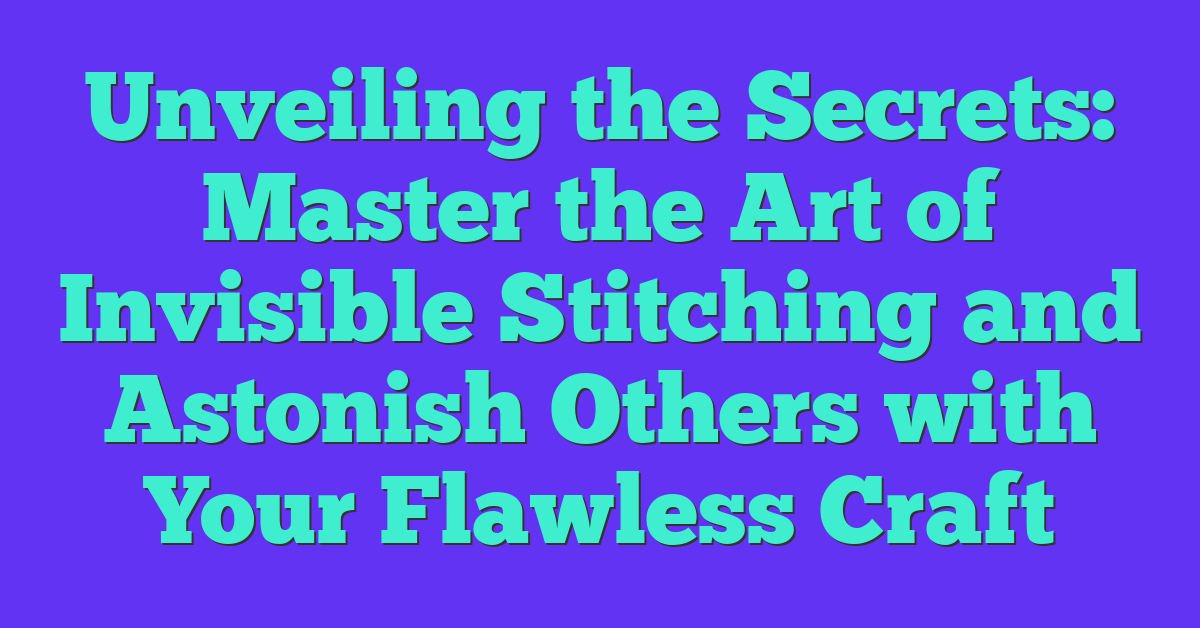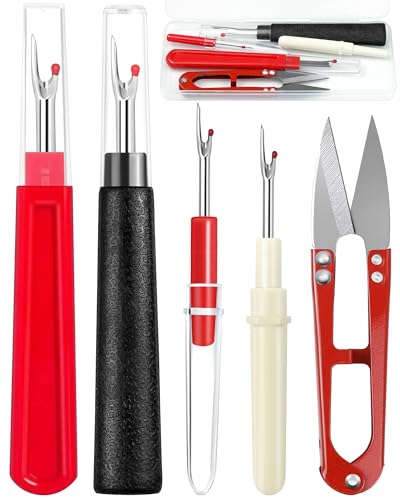Are you tired of your stitches showing on your sewing projects? Don’t worry, we’ve got you covered! In this article, we’ll show you some handy tips and tricks to help you stitch without showing the thread. Whether you’re a beginner or an experienced sewer, these techniques will help you achieve seamless and professional-looking results. Get ready to take your sewing skills to the next level!
Have you ever wondered how some people manage to stitch so flawlessly without a single thread in sight? Well, wonder no more! In this article, we’ll reveal the secrets to stitching without showing the thread. With a few simple adjustments to your sewing technique, you’ll be able to create clean and invisible stitches that will impress everyone. Say goodbye to visible threads and hello to a polished and professional finish!
What Is Invisible Stitching?
When it comes to achieving flawless and professional-looking stitch work, invisible stitching is the secret ingredient. Whether you’re working on sewing, embroidery, knitting, or any other craft projects, creating seams and stitches that are virtually undetectable can take your work to the next level.
Invisible stitching refers to a technique that conceals the thread used to join fabric or yarn together, giving the appearance of an uninterrupted and seamless finish. The goal is to make the stitches blend seamlessly into the fabric or yarn, creating a smooth and polished look.
By using this technique, you can create hems, seams, and decorative embellishments without the unsightly look of visible thread. Not only does invisible stitching enhance the overall appearance of your projects, but it also adds durability and strength to the seams. Whether you’re working on clothing, home decor, or accessories, invisible stitching is a skill that every crafter should have in their arsenal.
There are several methods to achieve invisible stitching, depending on the specific craft you’re working on. For sewing projects, hand stitching with a fine needle and matching thread color is key. You’ll want to make small, almost imperceptible stitches along the fabric edges, ensuring that the thread remains hidden within the layers. For knitting projects, techniques such as mattress stitch or grafting can be used to seamlessly join knitted pieces together without showing the thread.
Practice makes perfect when it comes to mastering invisible stitching. Take your time, experiment with different techniques, and don’t be afraid to unpick and start over if needed. With practice, you’ll develop a keen eye for detail and the ability to create invisible stitches that will elevate your projects to a professional level.
Benefits of Invisible Stitching
Invisible stitching is a valuable technique that can elevate the quality and aesthetics of your sewing, embroidery, knitting, and other craft projects. By concealing the thread used to join fabric or yarn together, you can achieve seamless and professional-looking results. Let’s explore the benefits of mastering invisible stitching:
- Enhanced Appearance: When you use invisible stitching, the focus is on the fabric or yarn itself, rather than the visible seams. This creates a clean and polished look, making your projects appear more refined and professional.
- Durability and Strength: Invisible stitching techniques, such as hand sewing or mattress stitch, create strong and secure seams that can withstand everyday wear and tear. By hiding the thread within the fabric or yarn, the stitches are less prone to snagging or unraveling, ensuring the longevity of your projects.
- Versatility: Invisible stitching is a versatile technique that can be applied to a wide range of projects. Whether you’re working on a garment, home decor item, or accessory, invisible stitching can enhance the overall finish and durability of your creations.
- Invisible Repairs: If you have a favorite item of clothing or a beloved knitted project that needs mending, invisible stitching can come to the rescue. With the right technique, you can seamlessly repair holes or tears, making them virtually indistinguishable from the original fabric or yarn.
- Professional Finish: Invisible stitching gives your projects a high-end and polished finish. Whether it’s a hand-sewn hem, a seamless join in knitting, or an invisible embroidery knot, these small details contribute to the overall professionalism and quality of your work.
Choosing the Right Thread and Needle
When it comes to achieving invisible stitching, one of the most important factors to consider is your choice of thread and needle. By selecting the right materials, you can ensure that your stitches blend seamlessly into your fabric or yarn. Here are some tips to help you choose the perfect thread and needle for your project:
Thread
- Match your thread color: To create stitches that disappear into the fabric or yarn, it’s vital to choose a thread that matches the color as closely as possible. Take the time to compare different thread shades against your materials to find the best match.
- Opt for fine thread: Using a thin and fine thread will help create more delicate and practically invisible stitches. Look for threads labeled as “fine” or “invisible.” These threads are designed to be less noticeable and are ideal for achieving a seamless finish.
- Consider the thread material: Different fabrics and yarns have different requirements when it comes to thread. For instance, when working with delicate fabrics like silk, a silk thread will give you the best results. Similarly, using a cotton or wool thread for knitting projects will help create cohesive, invisible stitches.
Needle
- Choose the right needle size: The needle size you use can impact the visibility of your stitches. For general sewing projects, opt for a fine needle that matches the thickness of your fabric. Make sure the needle is sharp to ensure smooth and precise stitching.
- Use a sharp-pointed needle: A sharp needle will easily penetrate the fabric or yarn, minimizing the appearance of the holes and making your stitches almost invisible. Be cautious and handle sharp needles with care to avoid accidental injury.
Remember, achieving invisible stitching requires practice and experimentation. Take the time to test different threads and needles on scraps of fabric or spare yarn before diving into your project. By choosing the right thread and needle and honing your stitching technique, you’ll be able to create beautiful, professional-looking crafts with hidden stitches.
So, now that you know how to choose the right thread and needle, let’s move on to exploring the various techniques you can use to achieve invisible stitching in different types of projects.
Threading the Needle Correctly
When it comes to achieving invisible stitching, one of the most crucial steps is threading the needle correctly. This simple task might seem insignificant, but doing it right will make a world of difference in your sewing, embroidery, knitting, and other craft projects.
Here are a few tips to help you thread the needle correctly and achieve those professional-looking results:
Use a Fine Needle and Matching Thread Color
First and foremost, make sure you’re using a fine needle that suits the fabric or yarn you’re working with. A needle with a small eye will allow for a more invisible thread appearance once stitched. Next, choose a thread color that matches your fabric or yarn. This will ensure that any stitches that do become visible blend seamlessly with the overall look of your project.

Double the Thread for Strength
To ensure durability and strength in your stitching, consider doubling your thread. This will create a more robust and secure seam. Alternatively, if you’re working on a delicate project that doesn’t require extra strength, a single thread may suffice.
Threading the Needle with Ease
Threading a needle can sometimes be a fiddly task, but with a few tricks, you’ll be threading it with ease. One technique is to wet the tip of the thread slightly before guiding it through the needle’s eye. This will help the thread glide through effortlessly. Another method is to cut the thread at a sharp angle, which makes it easier to thread.
Practice Makes Perfect
Finally, like any skill, practice is key in achieving invisible stitching. Take the time to experiment with different threads, needles, and techniques on scrap fabric or yarn before starting your project. This will give you the opportunity to fine-tune your skills and find what works best for you.
Techniques for Invisible Stitching
When it comes to achieving invisible stitching, there are various techniques you can use depending on the type of project you’re working on. These techniques will help you conceal the thread and create a seamless finish that will make your sewing, embroidery, knitting, or other craft projects look professional. Let’s explore a few of these techniques below:
Hand Stitching
For sewing projects, hand stitching is often the best choice for achieving invisible seams. By using a fine needle and matching thread color, you can seamlessly join fabric pieces without any visible stitching lines. The key here is to keep your stitches small and consistent, ensuring that the thread is barely visible.
Mattress Stitch
« Unveiling the Astonishing Secrets Behind Sewing Needle Sizes – Discover the Ultimate Guide Now
Discover the Insanely Creative Sewing Ideas for Cotton Fabric That Will Blow Your Mind »
If you’re working with knitting projects, the mattress stitch is an excellent technique for creating invisible seams. This method involves stitching the edges of your knitted pieces together using a tapestry needle and matching yarn. By weaving the needle in and out of the stitches, you can create an almost seamless join that is virtually undetectable.
Grafting
Grafting, also known as the Kitchener stitch, is another technique commonly used in knitting to achieve invisible seams. It involves seamlessly joining two sets of stitches by weaving the yarn through them, resulting in a seamless, invisible join. It’s particularly useful when joining the toes of socks, for example.
Remember, achieving invisible stitching requires practice and experimentation. Don’t be discouraged if your first attempts don’t turn out perfectly. Keep practicing and trying different techniques until you find the one that works best for your project.
By mastering these techniques, you’ll be able to enhance the appearance, durability, and strength of your sewing, embroidery, knitting, and other craft projects. Invisible stitching is not only visually appealing, but it also allows for invisible repairs and gives your creations a professional finish.
Next, let’s discuss tips for choosing the right thread and needle for your invisible stitching projects.
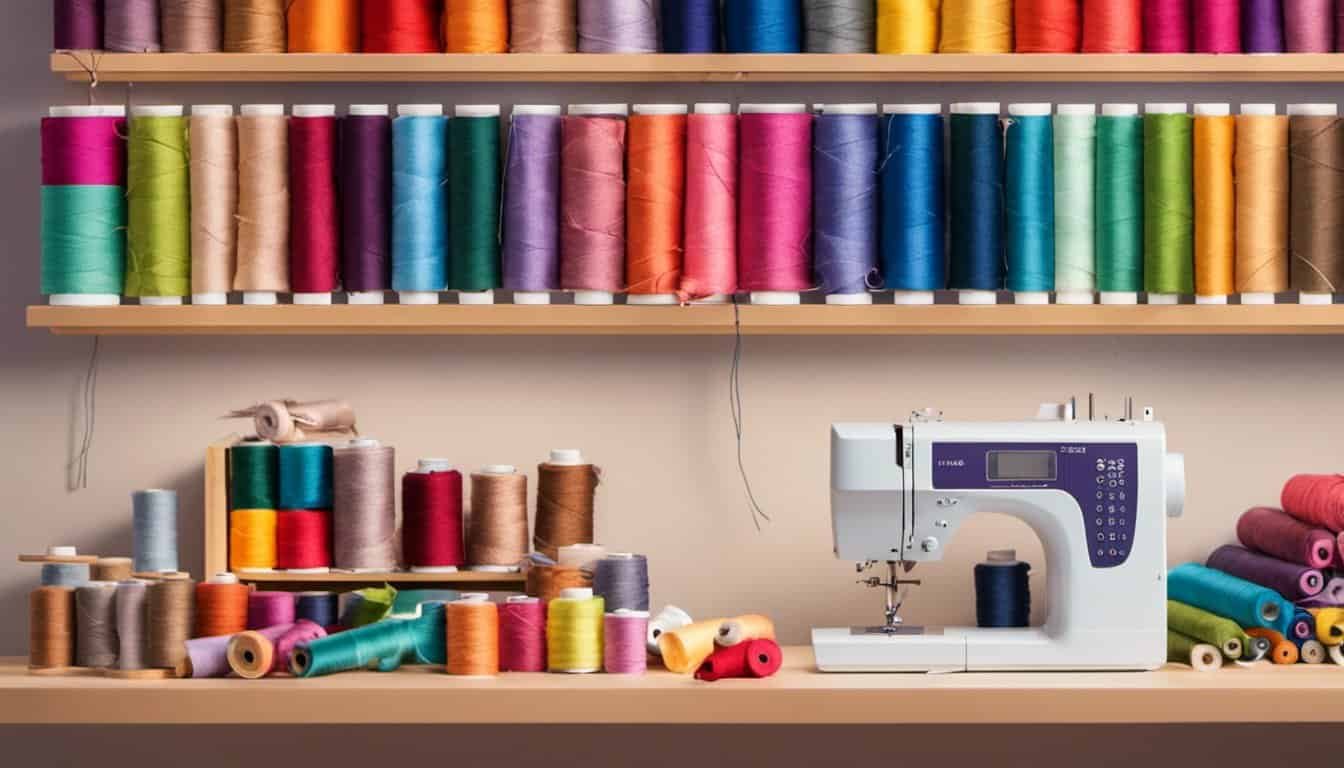
Using the Blind Hem Stitch
When it comes to achieving invisible stitching in your sewing projects, the blind hem stitch is an invaluable technique to have in your repertoire. Whether you’re hemming garments or sewing decorative elements, this stitch allows you to create a seamless finish that hides the thread and gives your project a professional look. Here are some tips on how to use the blind hem stitch effectively.
1. Prepare Your Tools: Start by selecting a fine needle that matches the color of your thread. This will ensure that the stitch blends seamlessly with the fabric. Additionally, make sure to choose a thread that is suited to your fabric type.
2. Set Up Your Machine: To begin, adjust your machine settings to accommodate the blind hem stitch. This may involve selecting the blind hem stitch option on your sewing machine, adjusting the stitch width and length, and using the appropriate presser foot.
3. Mark Your Hem Line: Before sewing your blind hem stitch, it’s crucial to mark the hem line accurately. For precision, use tailor’s chalk or a fabric pen to make small, discreet marks along the desired hemline.
4. Fold and Press: Next, fold the fabric along the marked hemline and press it with an iron to create a crisp, flat edge. This will make stitching the blind hem much easier and more accurate.
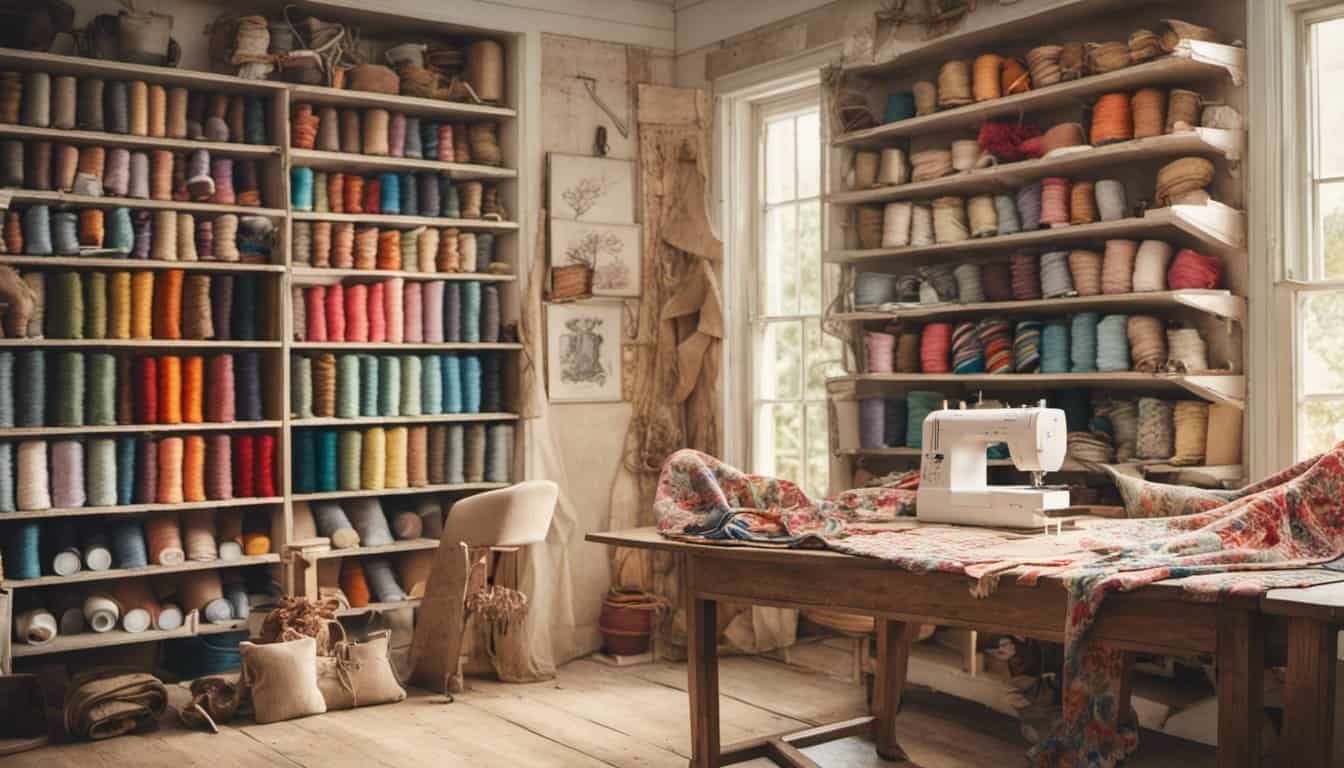
5. Position the Fabric: Place the folded edge of the fabric under the presser foot, aligning it so that the bulk of the fabric is to the right of the needle.
6. Stitch Away: Now it’s time to start stitching! As you sew, the blind hem stitch will create a series of small, barely noticeable stitches that attach the folded edge of the fabric to the main body. Be sure to guide the fabric accurately, maintaining a consistent seam allowance.
7. Finish with a Knot: Once you’ve sewn the entire hem, finish off with a small knot. This will secure the thread, preventing any unraveling and ensuring a clean, invisible finish.
By using the blind hem stitch, you can achieve professional-looking results on your sewing projects, leaving no trace of the thread behind. Practice this technique on scrap fabric before attempting it on your actual project to gain confidence and perfect your skills. With a little practice and experimentation, you’ll be able to master the art of invisible stitching and elevate the quality of your craft projects.
Proper Needle Placement
When it comes to achieving invisible stitching, needle placement plays a crucial role. The right needle position can make all the difference in creating seamless seams and hidden stitches. Here are some tips to help you with proper needle placement:
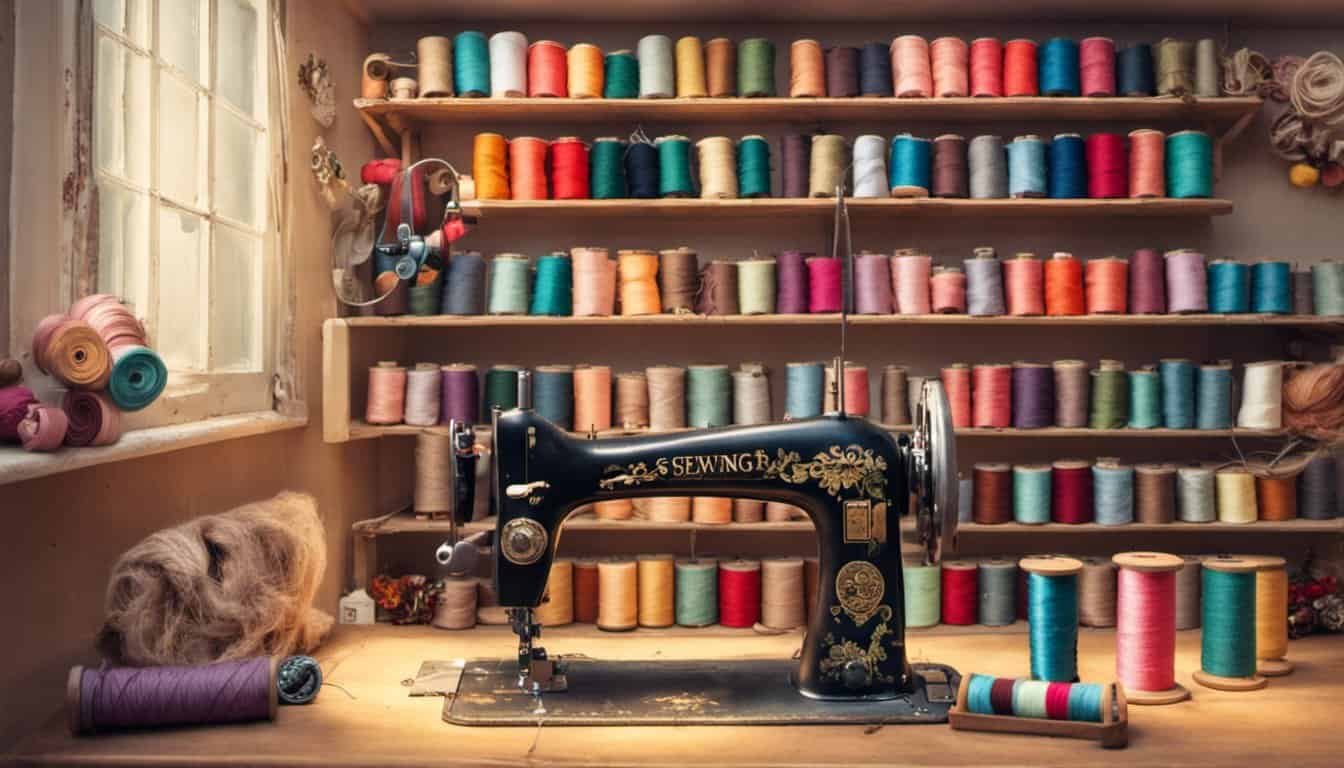
Choose the Right Needle Size
Before you begin stitching, it’s important to select the correct needle size for your project. Using a needle that is too big can leave visible holes in the fabric or yarn. On the other hand, using a needle that is too small can result in breaking or fraying of the thread. So, take your time to find the perfect needle size that matches the weight and thickness of your material.
Use a Sharp-Pointed Needle
A needle with a sharp point can effortlessly glide through the fabric or yarn, creating neat and precise stitches. It significantly reduces the chances of visible puncture marks or snagging the threads. So, make sure to choose a sharp-pointed needle for your stitching projects.
Position the Needle Correctly
When hand stitching, hold the needle in a way that allows you to insert it into the fabric or yarn at the correct angle. Insert the needle with a slight downward angle to ensure it goes through the material smoothly. Avoid pushing or forcing the needle, as it can cause the thread to tangle or the stitches to show.
Maintain Consistent Needle Depth
To achieve invisible stitching, it’s important to maintain a consistent needle depth throughout your project. Avoid stitching with uneven needle penetration, as it can lead to visible stitches. Keep your stitches consistently tight and ensure the needle depth is the same for each stitch.
Experiment and Practice
Don’t be discouraged if your first few attempts at invisible stitching don’t turn out perfect. Like any craft, achieving proficiency in invisible stitching takes practice and experimentation. Take the time to try different needle placements and techniques on scrap fabric or yarn before starting your actual project. The more you practice, the better you’ll become at achieving professional-looking invisible stitches.

Tying off and hiding the thread
When it comes to achieving invisible stitching, tying off and hiding the thread is a crucial step in ensuring a seamless finish to your sewing, embroidery, knitting, or crafting projects. By following a few simple techniques, you can achieve professional-looking results that will amaze your friends and family.
Sewing Projects
For sewing projects, securing and hiding the thread can be done by tying it off with a secure knot and then burying it within the layers of fabric. Here’s how you can do it:
- Secure the thread: Once you have finished sewing, leave a tail of thread about 4 to 6 inches long. Thread this tail through the loop of your last stitch to create a knot and pull it tight.
- Bury the thread: Thread a hand sewing needle with the remaining tail. Insert the needle into the seam allowance and weave it in and out of the fabric layers, following the path of your stitches, for about an inch. Pull the needle out and trim the excess thread close to the fabric.
Knitting Projects
In knitting, hiding the thread can be achieved through techniques like the mattress stitch or grafting. These methods create seamless joins between knitting pieces without showing any visible thread. Here’s how you can do it:
- Mattress stitch: Lay your knitting pieces right sides together and align the edges you want to join. Use a tapestry needle to weave the thread under the horizontal bars between stitches, alternating between the front and back pieces. Pull the thread snugly to close the gaps, and continue stitching until the seam is complete. Weave in the ends to secure and hide the thread.
- Grafting (also known as the Kitchener stitch): Grafting is perfect for seamless joins in ribbing or stockinette stitch. Align your knitting pieces parallel to each other with the right sides facing outward. With a tapestry needle, insert it knitwise into the first stitch on the front piece, then purlwise into the first stitch on the back piece. Continue this pattern until all stitches have been grafted, following the sequence “knit, purl, purl, knit.” Weave in the ends to secure and hide the thread.
By following these techniques, you can tie off and hide the thread in your sewing, embroidery, knitting, and crafting projects. Remember, practice makes perfect, so don’t worry if it takes a
Conclusion
By following the tips and techniques outlined in this article, you can achieve invisible stitching in your sewing, embroidery, knitting, and other craft projects. Remember to use hand stitching with a fine needle and matching thread color for sewing projects, and techniques like mattress stitch or grafting for knitting projects. Practice and experimentation are key to mastering invisible stitching and achieving professional-looking results.

When choosing the right thread and needle, consider factors such as matching the thread color to the fabric or yarn, using fine thread, and selecting the appropriate needle size. Testing different threads, needles, and techniques on scrap fabric or yarn before starting your project is always a good idea.
For sewing projects, the blind hem stitch is a great technique to achieve invisible stitching. Make sure to select the right tools, set up your sewing machine correctly, and follow the steps for marking, folding, positioning, stitching, and finishing with a knot. Practice this technique on scrap fabric before attempting it on your actual project.
Lastly, proper needle placement is crucial. Choose the right needle size, use a sharp-pointed needle, position the needle correctly, and maintain consistent needle depth. Don’t forget to experiment and practice to improve your skills.
Remember, with practice and attention to detail, you can achieve seamless, invisible stitching that will give your projects a professional finish. Happy stitching!


